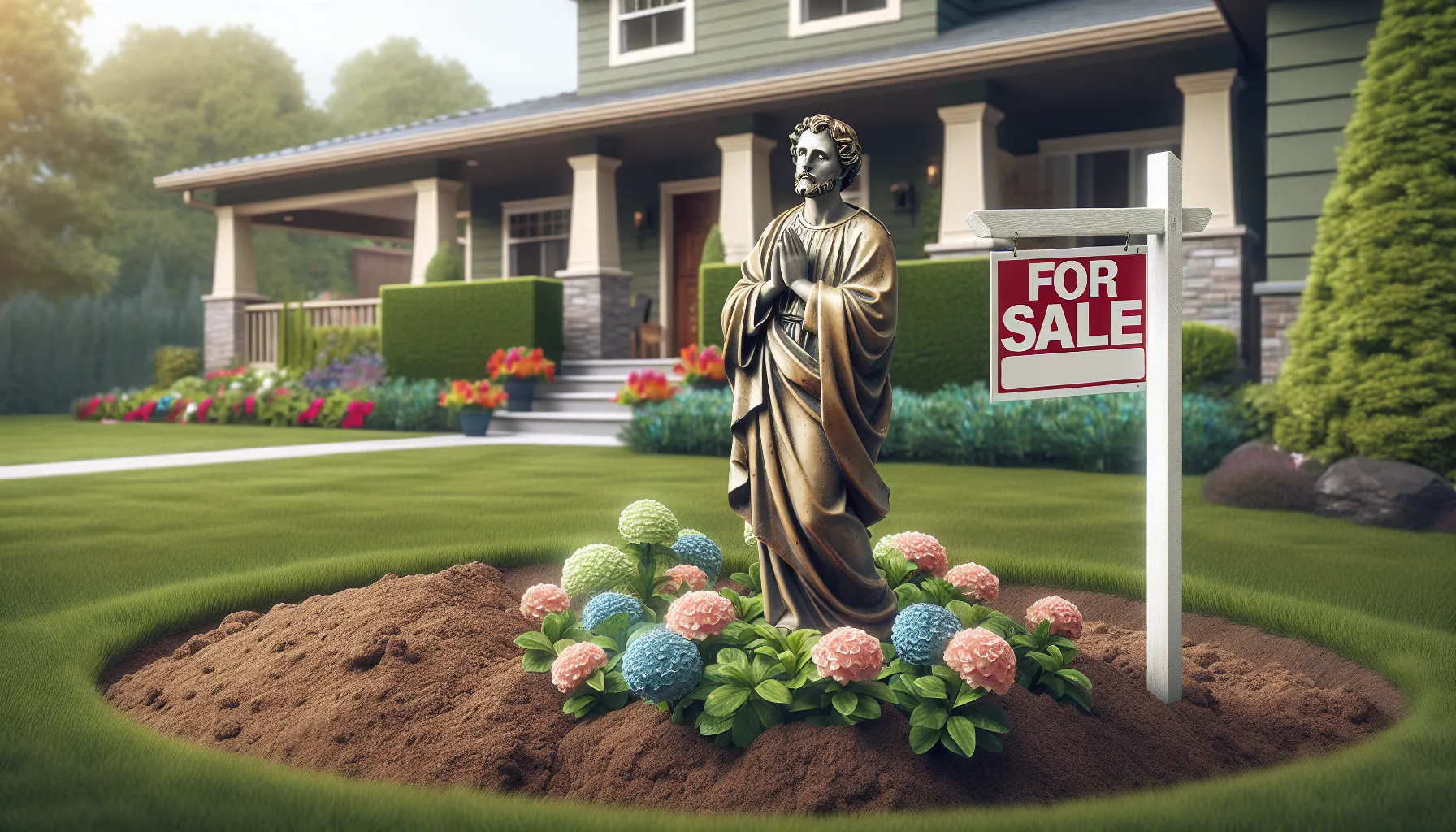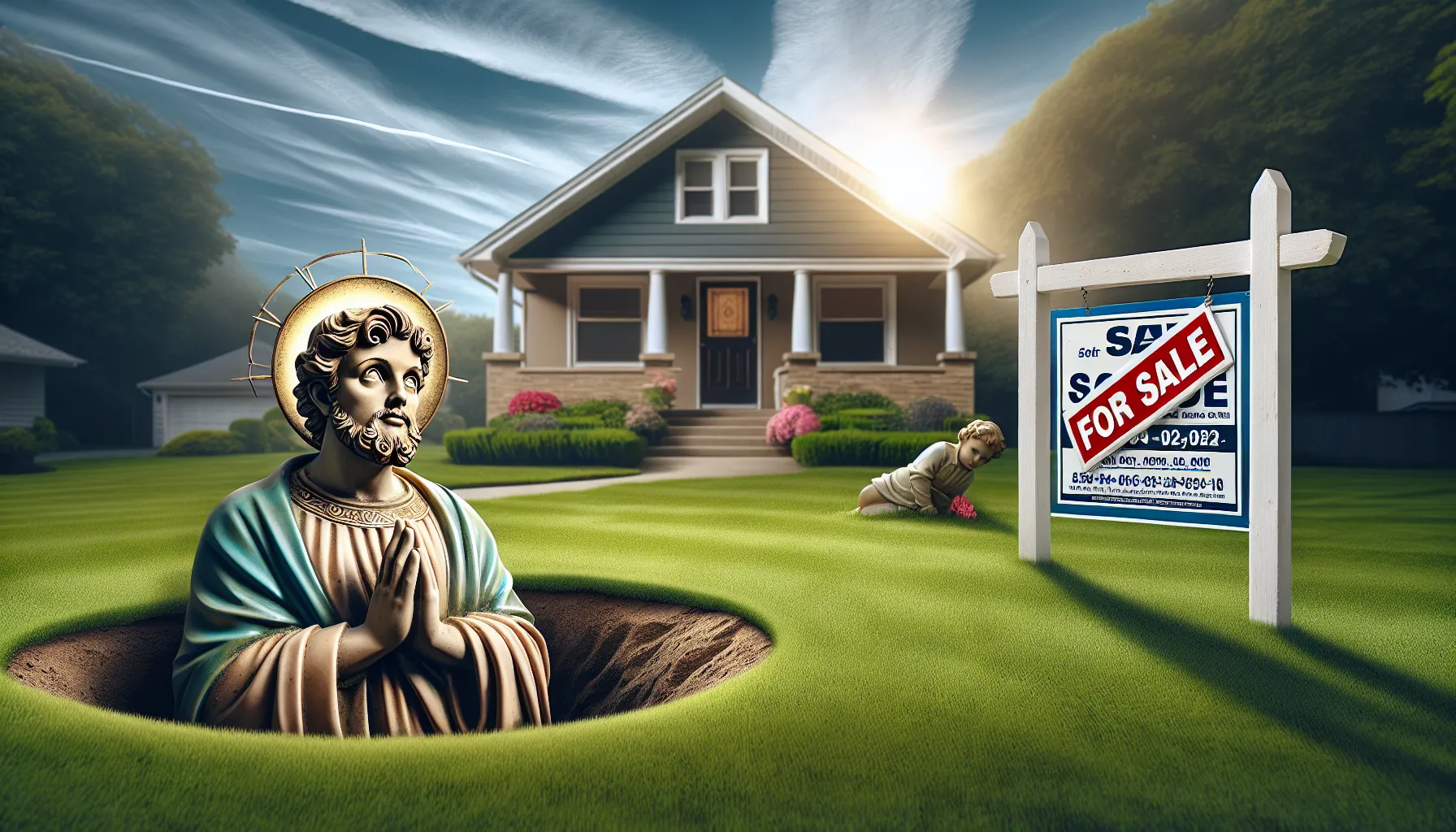Key Takeaways
- Tradition and Belief: Burying a St. Joseph statue is a long-standing tradition believed to help homeowners sell their properties quickly and fosters a sense of hope in the home-selling process.
- Historical Roots: The practice originates from 16th century Italy, recognizing St. Joseph as the patron saint of families and workers, and gained popularity in the U.S. in the 1970s.
- Ritual Significance: The ritual involves burying the statue upside down near the “For Sale” sign and saying a prayer, creating a communal experience that brings emotional support from family and friends.
- Anecdotal Evidence: Many homeowners report success stories after engaging in the ritual, claiming quicker sales and better offers, though skeptics attribute these successes to market conditions.
- Psychological Benefits: Engaging in this ritual can help reduce anxiety, instill hope, and promote resilience among sellers, providing a structured approach to the uncertainties of selling a home.
- Alternative Selling Strategies: Aside from burying the statue, homeowners can explore traditional methods like renting or modern strategies such as leveraging technology for virtual showings and data-driven pricing.
Have you ever heard the tale about burying a St. Joseph statue to sell your house? This quirky tradition has intrigued homeowners for generations, promising a quick sale and a smooth transaction. But does it really work?
Overview of the St. Joseph Statue Tradition
The tradition of burying a St. Joseph statue is rooted in the belief that this practice can assist homeowners in selling their properties quickly. Many draw on folklore that connects the statue to successful home sales, shaping a ritual that continues to resonate with those seeking favorable transactions.
Historical Background
This practice originates from 16th century Italy, where the Catholic Church recognized St. Joseph as the patron saint of workers and families. Over the years, this sentiment evolved, positioning him as a celestial figure supportive of home sales. The first known mention of burying the statue appears in a 1970s real estate article in the Chicago Tribune, which highlighted a couple’s success with the ritual. Since then, the tradition has expanded, particularly in the United States, becoming a common practice among those in real estate.
Cultural Significance
The act of burying the St. Joseph statue transcends mere superstition; it symbolizes hope and faith in the process of selling a home. Many believe that engaging in this ritual fosters a sense of community, as friends and family often participate in the burial, enhancing emotional support. The statue’s placement—usually upside down and facing the home—reflects a plea for assistance in achieving a quick sale. This tradition has woven itself into the fabric of many communities, signaling the lengths to which individuals will go to ensure a smooth transition in their housing journey.
How the Burying Process Works

Burying a St. Joseph statue involves a series of steps that many homeowners believe can help facilitate a successful home sale. Understanding these steps can clarify the significance of this tradition and its potential impact on the selling process.
Choosing the Right Statue
Choosing the right St. Joseph statue is crucial for those engaging in this ritual. Many options exist, from basic figures to more elaborate representations. Typically, a small statue measuring around 12 inches works best for burying in the yard. Some homeowners prefer representations that include specific details, such as a house or garden motif, believing these features enhance its effectiveness. We recommend selecting a statue that resonates personally or aligns with your home’s aesthetic. Additionally, purchasing from a reputable source can assure quality and authenticity, which adds to the tradition’s spirit.
The Burying Ritual
The burying ritual is symbolic and straightforward. Traditionally, homeowners bury the statue upside down and facing the house to signify a plea for assistance. The location of the burial is generally near the “For Sale” sign or entrance to the home, grounding the ritual in the property’s immediate environment. Before burying, it’s common to say a prayer or make a personal wish for a smooth sale, tapping into the spiritual significance of the act. After the house sells, homeowners often retrieve the statue, displaying it in a prominent place as a reminder of the successful transaction. Engaging in this ritual can provide emotional support and foster hope for our home-selling process.
Anecdotal Evidence and Testimonials

Homeowners often share experiences about the St. Joseph statue’s role in selling their properties. Many claim that after burying the statue, their homes sold faster than expected. For instance, one couple in California reported receiving an offer within a week of performing the ritual, attributing their success to the tradition. Another homeowner in Texas expressed relief at selling during a tough market, insisting that the statue played a significant part in their sale process.
Success Stories
Success stories abound regarding the practice of burying a St. Joseph statue. A family in Florida recounted their experience: after weeks of inactivity, they buried the statue upside down, aligned with their “For Sale” sign. Within days, they received multiple offers, leading to a competitive bidding situation. Similarly, a homeowner in New York shared that after burying the statue and reciting a heartfelt prayer, they received an offer significantly above their asking price. These stories highlight the perceived efficacy of this ritual within various communities, creating a sense of hope and potential for those faced with selling their homes.
Skeptical Perspectives
Skeptical perspectives also exist regarding the tradition of burying a St. Joseph statue. Critics argue that the success reported by some homeowners results from market conditions rather than the statue’s influence. Real estate agents often emphasize that engaging with pricing strategies and staging typically leads to faster sales. They remind us that market fundamentals, such as location and demand, usually dictate outcomes. Furthermore, some skeptics view the practice as a superstition, believing it distracts homeowners from focusing on more significant selling strategies and repairs that genuinely impact property value. This skepticism reinforces the need to weigh personal beliefs against practical, proven methods in real estate transactions.
The Symbolism Behind the Ritual
Burying a St. Joseph statue holds deep symbolic meaning for many homeowners. The act blends tradition with a sense of hope, often bringing together friends and family in support of a common goal. By involving loved ones, this ritual fosters a communal spirit, emphasizing the importance of faith in the home-selling process. The statue, often placed upside down, symbolizes a plea for assistance, reinforcing the belief that spiritual intervention plays a role in achieving a swift sale.
Faith and Belief
Faith plays a pivotal role in the ritual of burying the St. Joseph statue. Homeowners engage in this practice as an expression of confidence in a higher power’s influence over their circumstances. This belief can instill a sense of control in an otherwise unpredictable process. Many cite personal anecdotes of success, suggesting that the ritual acts as a conduit for their hopes. For example, some homeowners report receiving offers shortly after completing the ritual, attributing their quick success to the statue. This faith can provide emotional comfort, helping sellers navigate the challenges of real estate transactions.
Psychological Factors
Psychological factors significantly impact the effectiveness of the St. Joseph statue ritual. Engaging in this practice can reduce anxiety related to home sales by creating a structured approach to the unknown. The act of burying the statue can serve as a tangible commitment to selling, elevating a homeowner’s mental state during a stressful time. Additionally, the ritual may enhance feelings of optimism and hope, promoting resilience as sellers face market hurdles. Research suggests that the act of participating in rituals can lead to improved confidence and focus. By integrating the statue into their selling strategy, homeowners may find themselves more mentally prepared for the challenges ahead.
Alternatives to Selling Homes
Homeowners seeking alternatives to traditional selling methods have several options to explore. Whether aiming for speed, convenience, or financial necessity, these alternatives can provide viable solutions.
Other Traditional Methods
Other traditional methods for selling a home include renting, leasing, or engaging in a short sale. Renting offers homeowners the chance to generate income while the property’s value may appreciate over time. Leasing properties can also allow for long-term control over the asset, providing flexibility for homeowners in changing markets. Short sales, where a home sells for less than the outstanding mortgage, can prevent foreclosure but often require negotiation with lenders, which might delay the process. These options can present non-traditional pathways to managing property ownership, appealing to those looking to adapt their strategies based on personal circumstances.
Modern Real Estate Strategies
Modern real estate strategies often leverage technology for efficiency and reach. Virtual tours increase the visibility of homes in a competitive market while attracting diverse potential buyers—essential in today’s digital-first world. Online platforms facilitate direct sales to buyers, allowing homeowners to bypass traditional agents and save on commission fees. Additionally, professional staging services enhance property appeal, assisting in faster sales even amid varying market conditions. Homeowners can also use data analytics available through real estate platforms to set competitive pricing and marketing strategies, further empowering them throughout the selling process. By considering these contemporary approaches, we enable ourselves to make informed decisions tailored to our unique situations.
Conclusion
Burying a St. Joseph statue can be a meaningful ritual for those looking to sell their homes. While some swear by its effectiveness others see it as a charming tradition rooted in hope and community support. Regardless of its actual impact on the sale process it serves as a reminder of the emotional journey involved in selling a home.
We should remember that while rituals can provide comfort and a sense of control it’s essential to combine them with practical strategies. Focusing on market conditions pricing and staging will ultimately play a significant role in achieving a successful sale. Whether we choose to bury a statue or not embracing both belief and practicality can empower us during this important transition.
Frequently Asked Questions
What is the St. Joseph statue tradition for selling homes?
Burying a St. Joseph statue is a practice some homeowners believe helps sell their houses quickly. Originating in 16th century Italy, it symbolizes hope and faith in the home-selling process.
How should the St. Joseph statue be buried?
The statue is typically buried upside down and facing the home, often near the “For Sale” sign or entrance. Many homeowners include a prayer for a smooth transaction during the process.
Is there any evidence this practice works?
Some homeowners report faster sales after performing the ritual, but skeptics point out that market conditions often play a significant role in these outcomes.
How does this practice impact emotional well-being?
The ritual can foster a sense of community and emotional support, reducing anxiety and enhancing optimism for sellers. It allows them to feel empowered during the uncertain home-selling process.
What are alternatives to burying a St. Joseph statue?
Homeowners can consider other selling methods like renting, leasing, or short sales. Modern real estate strategies, leveraging technology and professional staging, can also expedite the selling process.






